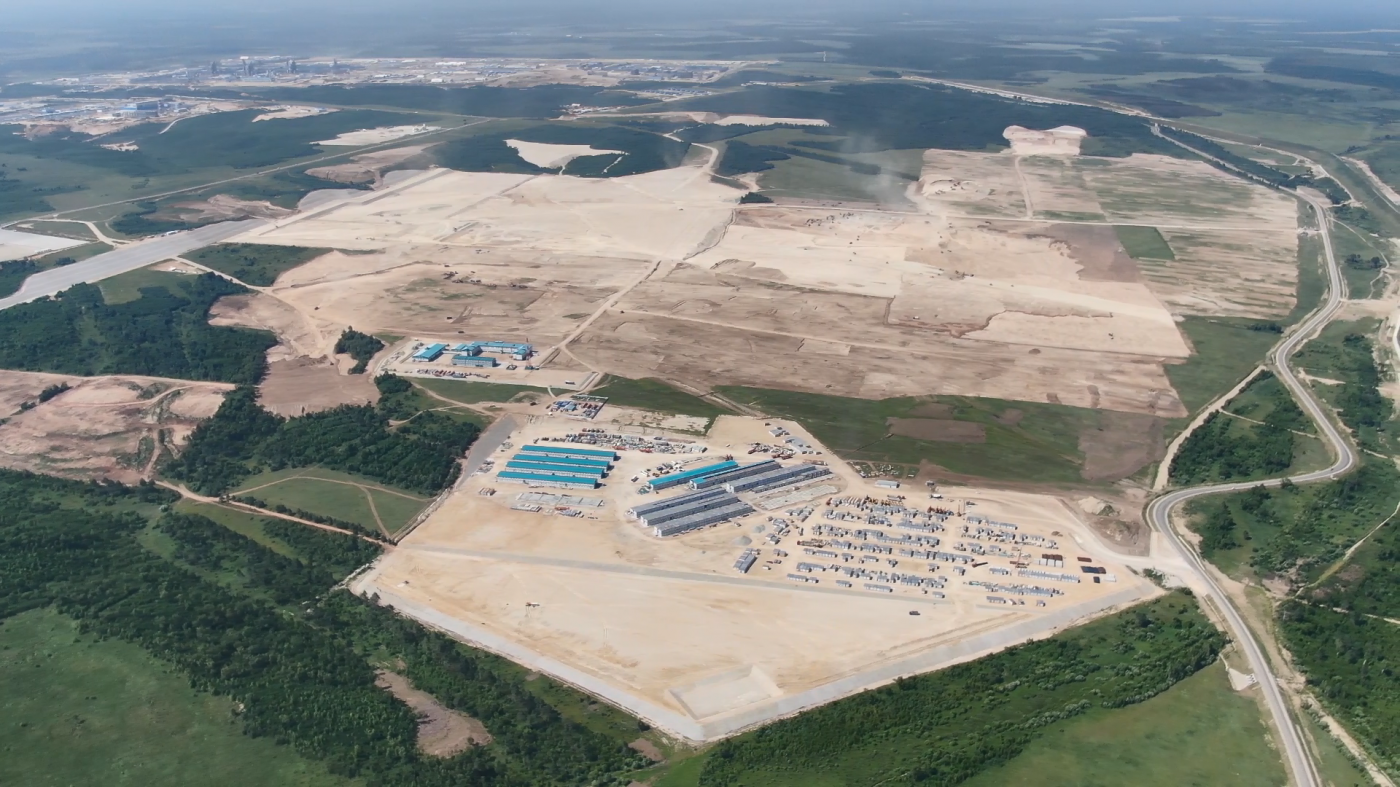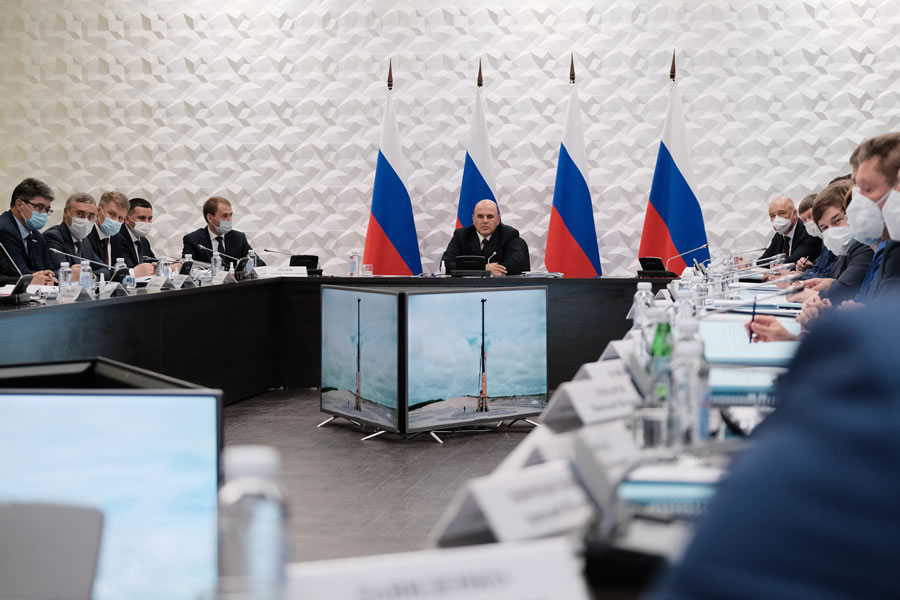The first test pile has been driven at the construction site of the Amur Gas Chemical Complex (AGCC), which is to become one of the world’s largest and most advanced basic polymers plants. The official ceremony was held online and was attended via video conference by Mikhail Mishustin, Prime Minister of the Russian Federation; relevant Ministers; Vasily Orlov, Governor of the Amur Region; Dmitry Konov, Chairman of the Management Board at SIBUR Holding, and other representatives of government authorities, the Company and its partners.
Where unique foreign licensed equipment is not required, the project will source up to 80% of supplies locally. Supplies such as metal structures, construction materials, laboratory and remote control equipment are all intended to come exclusively from local manufacturers
The Amur GCC project envisages the construction of a basic polymer production facility with a total capacity of 2.7 mtpa (2.3 mtpa of polyethylene and 400 ktpa of polypropylene). The facility will feature the world’s largest steam cracker (used for first-stage processing of incoming feedstock), unique in its specifications.
The construction of the complex will be in sync with the gradual ramp-up of Gazprom’s Amur GPP to full capacity. This facility will supply ethane and LPG to AGCC for further processing into high-value-added products. The tentative deadline for completing construction and start-up and commissioning is between 2024 and 2025. Once in operation, AGCC will provide a major impetus to the national non-commodity export development programme, as the complex’s production capacity is 1.35 times higher than Russia’s total polymer exports in 2019.
China’s state-owned Sinopec, the world’s largest petrochemical company, is expected to become SIBUR’s partner in the project. As the national champion of the oil and gas processing industry, Sinopec boasts an extensive distribution network in China for oil and gas products of varying processing levels. This country remains the key driver behind global polymer consumption growth and is a target market for the Amur GCC project.
Right now AGCC looks just like a construction site, but in the near future the complex is set to become a highly-efficient and highly-competitive production facility that will strengthen SIBUR’s position both in the domestic market and globally.
Most on-site preparations at the AMUR GCC have been completed. Contracts for detailed design and equipment as well as material supplies for the facility’s key process units have been signed and are being fulfilled. SIBUR’s technology partners are Linde and NIPIgaspererabotka (steam crackers), Univation Technologies and Chevron Phillips (ethylene polymerisation) and LyondellBasell (propylene polymerisation). NIPIgaspererabotka will be responsible for project design, procurement and construction of off-site facilities. Where unique foreign licensed equipment is not required, the project will source up to 80% of supplies locally – the highest reliance on local procurement among major gas chemical projects in Russia. Moreover, supplies such as metal structures, construction materials, laboratory and remote control equipment are all intended to come exclusively fr om local manufacturers.
“This is one of the largest investment projects in Russia that brings strategic benefits to the gas industry and the country at large. In a very short span of time, Russia’s Amur Region will see the opening of a giant factory with the most advanced production techniques based on modern IT and telecommunications technologies. Launching these technologies is an investment in the future. We are forging new growth paths for the Amur Region, giving an impetus to the local economy. I am confident that the project will create thousands of high-tech jobs and drive the development of transport and social infrastructure in the region. This will not only boost the economy, but will make the life of people in this beautiful place more comfortable. Building a gas chemical complex will unleash new opportunities for the region and, when coupled with the opening of a gas processing plant, will surely create a multiplier effect for the economy,” said Mikhail Mishustin.
“The Amur GCC is another step forward towards transforming SIBUR into a global-level petrochemical company. The complex will be a key project in SIBUR’s investment programme for the next five years and upon commissioning will almost double our basic polymer production capacities,” said Dmitry Konov, commenting on the project’s prospects
“The Amur GCC, for which we are laying the foundation today, is a world-class project of high strategic importance to our region. It will create a multiplier effect, improving the image of the region, attracting investment, contributing to the region’s GDP and generating tax revenues for budgets of all levels, as well as facilitating the development of related and associated industries and social infrastructure. As a highly resource-intensive project, this facility will increase the number of jobs at both the construction and post-commissioning stages. With a new gas chemical cluster in place, students and graduates will have a wider choice of careers to pursue. This will help us curb talent outflow and offer the youth new digital professions and opportunities for well-paid, interesting jobs in the Russian Far East,” said Vasily Orlov.
In addition to the Amur GCC, the nation’s largest gas processing and gas chemical cluster will be created in the Russian Far East to boost the region’s development. What makes the project even more important is the fact it is a stepping stone to unlocking the country’s huge non-commodity export potential. Deep conversion of ethane, a key feedstock for the Amur GCC, quadruples the added value of the resulting product. By 2040, the project is expected to increase non-commodity exports by RUB 4.6 trillion. The project’s significant role is acknowledged by the agreement to make the Amur GCC a tenant of the Svobodny Priority Development Area, which was signed by Alexei Vereshchagin, CEO of the Amur GCC, and Dmitry Tetenkin, Director General of the Far East Development Corporation.
“The Amur GCC is another step forward towards transforming SIBUR into a global-level petrochemical company. The complex will be a key project in SIBUR’s investment programme for the next five years and upon commissioning will almost double our basic polymer production capacities, even taking into account ZapSibNeftekhim, which is currently ramping up to its full-scale output level. Long-term forecasts for petrochemical demand, proximity to sales markets and a well-thought-out feedstock base give us confidence that the Amur GCC will be a highly effective and competitive business that will help SIBUR gain a strong foothold both in Russia and globally,” said Dmitry Konov.
Prime Minister Mikhail Mishustin and other members of the Government watched the start of construction for Russia’s largest gas-chemical complex via video link.
SIBUR’s head also added that the Company will market AGCC’s polymers using its own platform.
“We already have a joint venture (with Sinopec, which plans to acquire 40% equity interest in AGCC – SIBUR for Clients), for which we are awaiting regulatory approvals, and it will market the products. If we are fortunate enough to start selling, say, to Indonesia, the joint venture itself will receive the proceeds, not Sinopec or SIBUR. Alternatively, if Sinopec sells shipments in China, the JV will still receive the money, with Sinopec taking away a commission,” said Dmitry Konov.
He also noted that the Amur GCC would be built in one stage, just like the ZapSibNeftekhim petrochemical complex. A rail link to the Trans-Siberian Railway will need to be built to support the shipments of products.
According to Dmitry Konov, SIBUR plans to export a significant portion of the Amur GCC’s polymers, as the size of the Russian market is not large enough. The Company expects the new project’s products to gain a roughly 5% share of the Asian market. “The size of the world polymer market for polyethylene and polypropylene is 200 million tonnes, with Southeast Asia accounting for roughly a third of that. The Amur GCC’s projected share of that market is currently estimated at around 5%. That’s not the kind of figure that is expected to lead to market shifts, as the market grows by approximately 8 million tonnes every year,” SIBUR’s head said.
“In Russia, we plan to sell as much as the market is able to consume,” he noted.
SIBUR plans to export a significant portion of the Amur GCC’s polymer output. The Company expects the new project’s products to gain a roughly 5% share of the Asian market
Mr Konov also discussed the outlook for Asian demand for AGCC’s products. “Here it’s a matter of how competitive you are: where you stand on the cost curve, and whether you are able to sell more cheaply than your rivals, if need be. On this front too, in terms of performance quartiles, both ZapSib and the Amur GCC are in the top quartile, i.e. among the top 25% most efficient manufacturers. You can enter a tight market, but your product needs to be either cheaper or better than those offered by your rivals. And this holds true for any other product – when you are able to produce more cheaply than others in a weak market, then you will find a buyer, beating out others with more expensive products,” he said.
The Amur GCC will be the world’s first petrochemical complex to implement a remote control room. The project will benefit from over 150 digital and automated solutions and 24/7 remote monitoring and control of the majority of process operations. The Amur GCC is set to become an example of one of the most advanced solutions in engineering data management, with technical documents, engineering data and the project’s 3D model all aligned and available in just one click. The project data will be accumulated and made accessible both at the construction stage and during operation for future refurbishments, modernisations, repairs and maintenance.
In line with SIBUR’s Sustainability Strategy, the Amur GCC will employ state-of-the-art processes, such as smokeless flaring and using renewable energy sources wh ere possible, both seen as emerging best practices that are gaining traction in the industry as it seeks to reduce its carbon footprint.
Download PDF









